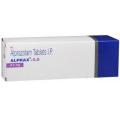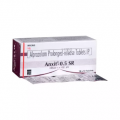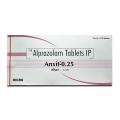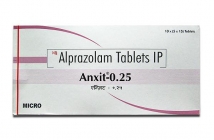Home / Categories / ALREST-0.5 TAB

ALREST-0.5 TAB
(10X20)
ALPRAZOLAM-0.5MG
BENZODIAZEPINES
PANAS PHARMACEUTICALS- KALASH DIVISION
Product Details
Alprazolam
Action
Indications
Contraindications
Route/Dosage
Interactions
Lab Test Interferences
Adverse Reactions
PrecautionsPatient Care Considerations
Administration/Storage
Assessment/Interventions
Patient/Family Education
(al-PRAY-zoe-lam)Xanax, Alti-Alprazolam, APO-Alpraz, Gen-Alprazolam, Novo-Alprazol, Nu-Alpraz Xanax TS
Class: Antianxiety/benzodiazepine
Action Potentiates action of GABA (gamma-aminobutyric acid), an inhibitory neurotransmitter, resulting in increased neuronal inhibition and CNS depression, especially in limbic system and reticular formation.
Indications Management of anxiety, anxiety associated with depression, panic disorder with or without agoraphobia. Unlabeled use(s): Treatment of irritable bowel syndrome, depression, PMS, agoraphobia with social phobia.
Contraindications Hypersensitivity to other benzodiazepines; psychoses; acute narrow-angle glaucoma.
Route/Dosage
Anxiety Disorder
ADULTS: PO 0.25 to 0.5 mg tid; max 4 mg/day in divided doses.
Elderly/Debilitated Patients
ADULTS: PO 0.25 mg bid to tid; may increase dose gradually.
Panic Disorder
Initial dose: PO 0.5 mg tid; if needed, increase by max 1 mg/day q 3 to 4 day. May require > 4 mg/day.
Interactions
Alcohol and other CNS depressants: Produce additive CNS depressant effects. Cimetidine, oral contraceptives, disulfiram: May increase effects of alprazolam, producing excessive sedation and impaired psychomotor function. Digoxin: Serum digoxin concentrations may increase. Omeprazole: May increase serum levels of alprazolam and enhance alprazolam's effects. Theophyllines: May antagonize sedative effects of alprazolam.
Lab Test Interferences None well documented.
Adverse Reactions
CV: Hypotension. CNS: Drowsiness; confusion; ataxia; dizziness; fatigue; apathy; memory impairment; disorientation; anterograde amnesia; restlessness; headache; slurred speech; aphonia; stupor; coma; euphoria; irritability; vivid dreams; psychomotor retardation; paradoxical reactions (eg, anger, hostility, mania, insomnia, muscle spasms). DERM: Rash. EENT: Visual or auditory disturbances; depressed hearing. GI: Constipation; diarrhea; dry mouth; coated tongue; nausea; anorexia; vomiting. HEMA: Blood dyscrasias, including agranulocytosis; anemia; thrombocytopenia; leukopenia; neutropenia; decreased hematocrit levels. HEPA: Hepatic dysfunction, including hepatitis and jaundice. OTHER: Elevated LDH, ALT, AST, and alkaline phosphatase.
Precautions
Pregnancy: Category D. Lactation: Excreted in breast milk. Children: Safety and efficacy in children < 18 yr not established. Dependence: Prolonged use can lead to physical and psychological dependence. Withdrawal syndrome has occurred within 4 to 6 wk of treatment, especially if abruptly discontinued. Cautious use and tapering of dosage are necessary. Psychiatric disorders: Not intended for patients with primary depressive disorder, psychoses, or disorders in which anxiety is not prominent. Renal or hepatic impairment: Caution is needed to avoid accumulation of drug. Suicide: Use with caution in patients with suicidal tendencies; do not allow patient access to large quantities of drug.
PATIENT CARE CONSIDERATIONS
Administration/Storage
- May be given with food if GI upset occurs.
- If patient has difficulty swallowing, crush tablets.
- Store in light-resistant container at room temperature.
Assessment/Interventions
- Obtain patient history, including drug history and any known allergies. Note hypersensitivity to other benzodiazepines and presence of narrow-angle glaucoma.
- Assess patient's mental status and extent of anxiety before initiation of therapy.
- Assess for the following signs of withdrawal syndrome: Confusion, abnormal perception of movement, depersonalization, muscle twitching, psychosis, paranoid delusions, seizures.
- Notify physician if signs/symptoms of the following conditions occur: Digoxin toxicity—anorexia, nausea, vomiting, diarrhea, visual disturbances, arrhythmias; hepatic dysfunction—fatigue, jaundice, abdominal pain, elevated liver enzyme levels; paradoxical reactions—anger, hostility, episodes of mania and hypomania; or cardiovascular reactions—tachycardia, arrhythmias, hypotension.
Patient/Family Education
- Advise patient against reducing or suddenly discontinuing this medication, which may cause withdrawal symptoms (eg, sweating, vomiting, muscle cramps, tremors, seizures).
- Caution patient to avoid sudden position changes to prevent orthostatic hypotension.
- Instruct patient to avoid intake of alcoholic beverages or other CNS depressants.
- Caution patient that prolonged use of this medication can lead to dependence.
- Advise patient that drug may cause drowsiness, and to use caution while driving or performing other tasks requiring mental alertness.
Books@Ovid
Copyright © 2003 Facts and Comparisons
David S. Tatro
A to Z Drug Facts









